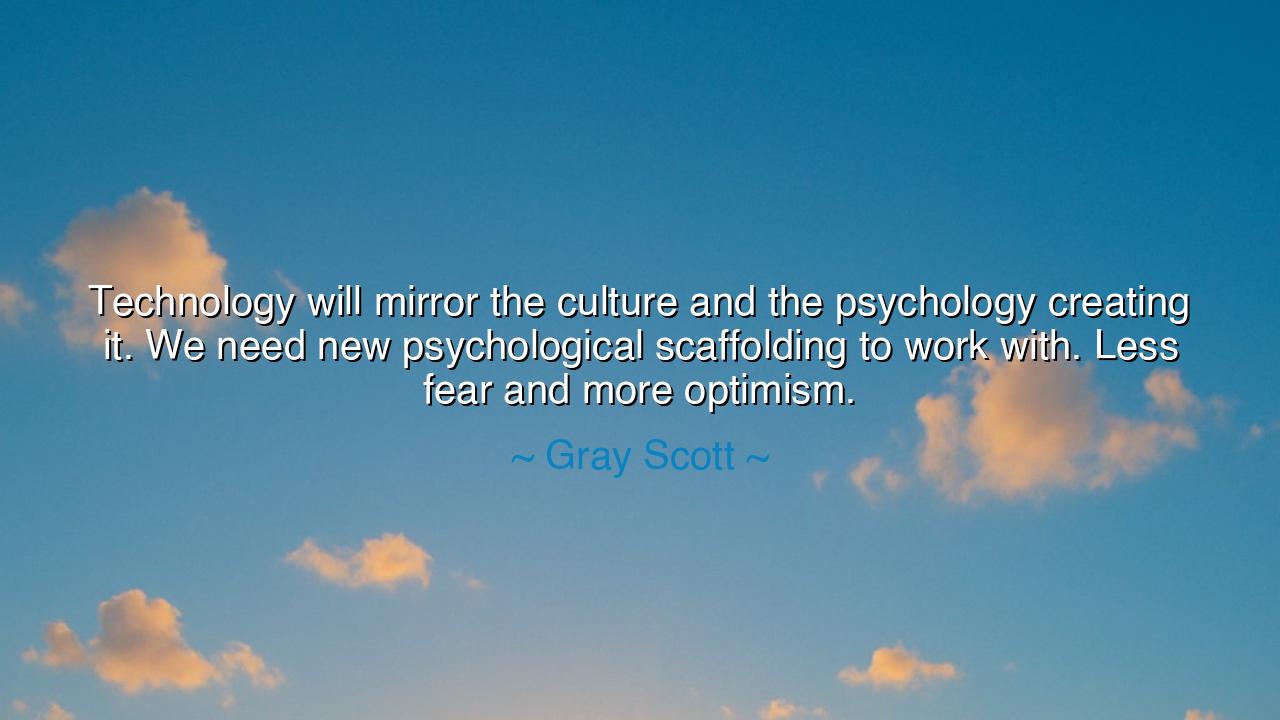
Technology will mirror the culture and the psychology creating
Technology will mirror the culture and the psychology creating it. We need new psychological scaffolding to work with. Less fear and more optimism.






Hear now the words of Gray Scott, futurist and seer of human destiny: “Technology will mirror the culture and the psychology creating it. We need new psychological scaffolding to work with. Less fear and more optimism.” These words shine like a beacon across the darkened seas of our age. For he reminds us that the machines we create are not neutral, nor are they gods apart from us—they are mirrors, reflecting back the spirit of their makers. If our souls are bound by fear, our inventions will bind humanity in chains; but if our hearts are guided by hope, our tools will lift us higher than ever before.
When Scott declares that technology mirrors culture, he points to a law as old as civilization. Every tool mankind has forged has carried within it the values, desires, and flaws of its age. The sword was born of an age of conquest, the printing press of an age of inquiry, the steam engine of an age of industry. Each invention bore not only function, but spirit—an echo of the psychology of those who created it. Thus, technology is not separate from us; it is the reflection of who we are. If we live in division, our technologies will divide. If we live in harmony, our technologies will unite.
He speaks also of psychological scaffolding, a powerful image. Just as great buildings require scaffolds to rise steadily, so too does human progress require inner frameworks to support it. In an age where technology races ahead with terrifying speed, our old mental structures—built on fear of scarcity, fear of the unknown, fear of one another—are no longer sufficient. To walk boldly into the future, we must construct new scaffolds of thought: structures of resilience, trust, curiosity, and above all, optimism. Without them, our inventions will outgrow our spirits and turn against us.
History offers us both warning and inspiration. When the atomic age dawned, the brilliance of physics split the atom and unleashed immense power. Yet the psychology that guided its use was steeped in fear, rivalry, and suspicion. The result was not only energy to light cities, but weapons capable of destroying nations. The technology mirrored the culture that created it—brilliant in science, but fearful in spirit. Contrast this with the creation of the International Space Station, where nations once divided by conflict chose cooperation. In that endeavor, optimism prevailed, and the technology became not a weapon, but a bridge among peoples.
The meaning of Scott’s words is therefore clear: the greatest danger to humanity is not the tool itself, but the heart of the maker. A fearful culture will birth fearful technologies. An optimistic culture will create tools of hope. What we see before us in the machines of tomorrow—artificial intelligence, biotechnology, and digital networks—will not only reflect what we can do, but what we believe about ourselves and one another. Thus, the true battle is not with machines, but within the human spirit.
The lesson for us is urgent: if we wish for our technology to heal, we must heal ourselves. If we wish for our machines to serve unity, we must cultivate unity. If we wish for our tools to spread wisdom, we must first seek wisdom. The scaffolding we need is not built of steel, but of virtues—courage, humility, compassion, and hope. By nurturing these, we prepare the ground for technologies that uplift rather than oppress.
Practical action is plain: resist the temptation to fear every new invention. Instead, meet the future with informed curiosity. Build communities that discuss technology not only in terms of profit, but in terms of human flourishing. Teach the next generation not only to code, but to imagine with optimism what their creations might bring. Demand of leaders and inventors that they shape tools in service of life, not domination. For in this lies the true scaffolding of the future.
Thus, Gray Scott’s words are not a prediction, but a call to arms of the spirit: “Technology will mirror the culture and psychology creating it.” Let us then be a culture of vision, not of fear; a psychology of courage, not of despair. For if we build with optimism, our technologies will become wings to carry us into brighter skies. The mirror is in our hands—let us reflect the light, not the darkness.






AAdministratorAdministrator
Welcome, honored guests. Please leave a comment, we will respond soon